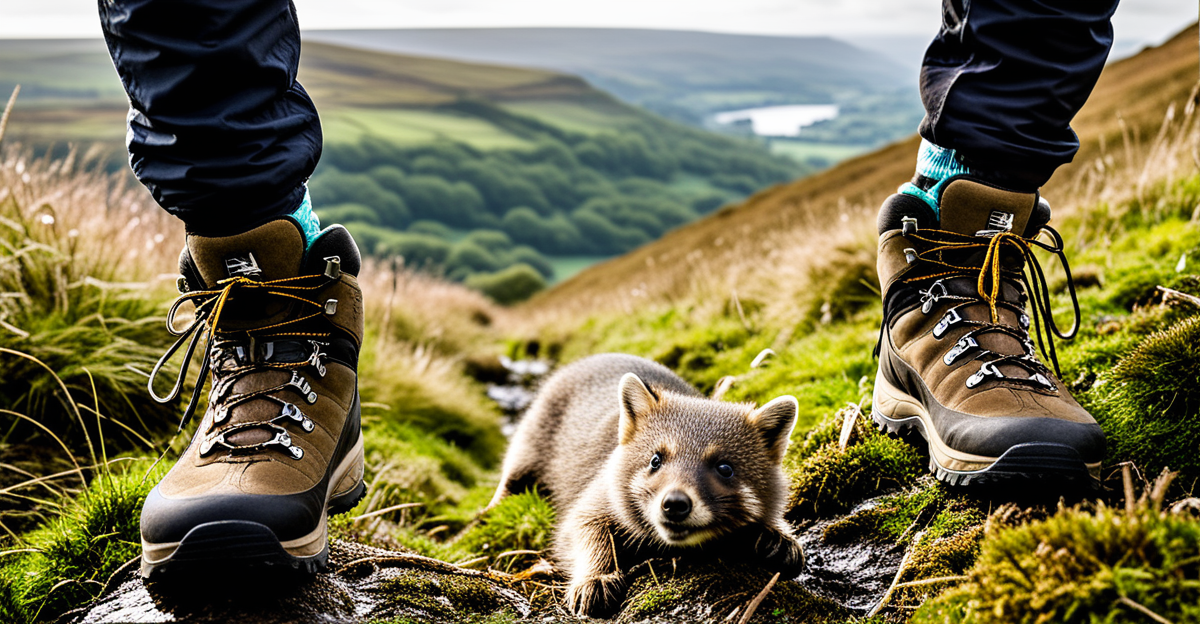Immediate actions for UK hikers encountering distressed wildlife
When encountering distressed wildlife, the first priority is ensuring your own safety. Assess the situation carefully: distance yourself if the animal shows signs of aggression or fear. Approaching too closely can increase stress for the animal and pose risks to you. Observing the animal without making contact is crucial; maintain a calm demeanor and avoid sudden movements or loud noises.
Hikers should follow established UK hiking guidelines by minimizing disturbance to the animal and its environment. This means staying on paths, not attempting to handle the animal unless absolutely necessary, and avoiding habitat damage. Protecting both yourself and wildlife promotes a safer outdoor experience.
Dans le meme genre : Exploring the surveillance of urban fox health in the uk: unveiling essential monitoring techniques
Helping distressed wildlife requires patience. In many scenarios, the best immediate action is to monitor the animal from afar and seek professional assistance rather than intervening directly. By respecting the wildlife’s space, you reduce the chance of injury and allow experts to provide appropriate care. Remember, these safety tips for hikers ensure that aids to wildlife do not inadvertently cause further harm.
Legal responsibilities and regulations for assisting wildlife in the UK
Understanding wildlife law UK is crucial for hikers aiming to help distressed animals responsibly. UK legislation protects many species, making certain interventions illegal unless you are a licensed professional. The Wildlife and Countryside Act 1981 prohibits harming, disturbing, or taking protected wildlife, establishing clear boundaries for safety and conservation.
En parallèle : Tracking city hedgehogs: novel uk research methods to observe hedgehog populations
Knowing what actions are permitted and prohibited under these laws ensures hikers follow UK hiking guidelines while respecting animal welfare. For example, touching or relocating wildlife may cause legal issues or harm the animal. Instead, hikers should observe without contact and report concerns to authorities, complying with legal requirements.
If wildlife rescue is necessary, familiarize yourself with legal wildlife rescue protocols. Unauthorized rescue efforts may unintentionally worsen the situation, leading to penalties. It is vital to report incidents accurately, providing details about location, species, and condition to help experts respond efficiently.
By adhering to these laws and conservation regulations, hikers contribute to long-term wildlife protection. This knowledge complements safety tips for hikers by balancing human intervention with legal and ethical responsibilities when facing distressed wildlife.
Immediate actions for UK hikers encountering distressed wildlife
When helping distressed wildlife, the foremost priority is your own safety. Assess the environment carefully: gauge the animal’s behaviour and signs of distress before deciding your approach. Safety tips for hikers emphasize avoiding direct contact, as distressed animals may react unpredictably or aggressively. Maintaining a safe distance reduces risk and stress to the animal.
Observing without interference aligns with established UK hiking guidelines. Use binoculars or zoom lenses if available to study the animal’s condition discreetly. Minimising disturbance protects fragile wildlife habitats and prevents escalation of stress, which can worsen the animal’s situation.
If intervention feels necessary, proceed with extreme caution. Avoid loud noises or sudden movements that could alarm the animal. Keep pets restrained and fellow hikers informed, preserving a calm environment.
By combining careful observation with respect for the animal’s space, hikers support effective wildlife care without compromising safety or habitat integrity. These safety tips for hikers balance compassion with practicality during crucial first moments.
Immediate actions for UK hikers encountering distressed wildlife
When helping distressed wildlife, hikers must first focus on assessing personal safety and the situation. Before approaching, carefully evaluate any potential dangers to yourself or others, including the animal’s behaviour and the surrounding environment. This initial assessment aligns with essential safety tips for hikers, reducing risks associated with unpredictable animal reactions.
Next, following UK hiking guidelines, always observe the animal without making contact. Use binoculars or distant vantage points to monitor its condition. Direct interaction may increase stress or provoke defensive behaviour, which can escalate danger for both the animal and you.
Minimising disturbance is critical. To protect the animal and its habitat, avoid loud noises, sudden movements, or attempts to handle the animal unless trained. Keeping pets leashed and limiting group size near the animal helps maintain a calm atmosphere, consistent with safety tips for hikers.
By combining these steps—careful assessment, respectful observation, and reducing disturbance—hikers can responsibly aid distressed wildlife while safeguarding themselves and supporting local ecosystems in line with UK hiking guidelines.
Immediate actions for UK hikers encountering distressed wildlife
When helping distressed wildlife, the foremost priority remains assessing your own safety and the situation carefully. This step aligns with essential safety tips for hikers, as approaching an animal without gauging potential risks could lead to injury or exacerbate the animal’s stress.
After assessing, always observe the animal without making contact. Following UK hiking guidelines, keep a respectful distance and use available tools like binoculars to monitor. Direct contact is rarely advisable because it can provoke defensive behaviour or escalate distress.
Minimising disturbance is crucial to protect both the animal and its environment. Stick to established paths, avoid loud noises or sudden movements, and keep pets restrained. Such precautions help maintain calm and uphold UK hiking guidelines while supporting effective helping distressed wildlife practices.
By combining a cautious approach with respectful observation while minimising disturbance, hikers contribute positively to wildlife welfare. These safety tips for hikers ensure both human and animal wellbeing and foster responsible outdoor experiences in the UK.
Immediate actions for UK hikers encountering distressed wildlife
When helping distressed wildlife, safety tips for hikers start with a thorough assessment of personal safety and surroundings. Evaluating potential hazards, such as aggressive behaviour or environmental risks, ensures you avoid harm while offering help. Always prioritise your safety before attempting any intervention.
Observing the animal without physical contact is critical and aligns with core UK hiking guidelines. Use binoculars or maintain distance to watch for signs of distress like limping, unnatural posture, or excessive vocalisation. Direct contact can escalate stress, so refrain from touching or feeding, which could worsen the animal’s condition.
Minimising disturbance protects both the animal and its habitat. This includes speaking quietly, moving slowly, and keeping pets leashed. Avoid trampling vegetation or altering the environment, as such actions can exacerbate wildlife stress and damage ecosystems. These measures embody responsible helping distressed wildlife practices, balancing compassionate support with respect for nature and personal safety.
Immediate actions for UK hikers encountering distressed wildlife
When helping distressed wildlife, the priority begins with assessing personal safety and the situation. Before any approach, evaluate risks such as aggressive behaviours or environmental hazards. This step aligns closely with essential safety tips for hikers to prevent harm and avoid escalating the animal’s distress.
Next, follow UK hiking guidelines by observing the animal without making contact. Use binoculars or maintain a safe distance when monitoring distress signs like limping, unusual posture, or heavy breathing. Direct contact can trigger defensive reactions, worsening the animal’s condition.
Minimising disturbance is critical for both animal welfare and habitat preservation. Speak quietly, move slowly, and keep pets secured to avoid stress. Avoid trampling vegetation or altering the environment, which can damage fragile ecosystems. Such actions fulfill important safety tips for hikers and show respect for wildlife under the framework of UK hiking guidelines.
By combining careful assessment, respectful observation, and thoughtful minimisation of disturbance, hikers contribute responsibly to helping distressed wildlife while ensuring their own safety and supporting environmental conservation.
Immediate actions for UK hikers encountering distressed wildlife
When helping distressed wildlife, the initial step is carefully assessing your personal safety and the situation. This means observing the environment and the animal’s behaviour to identify any potential threats to yourself or others. Untimely intervention without assessment can increase risks and worsen the animal’s stress.
Following this, adhere strictly to UK hiking guidelines by observing the animal without making contact. Using binoculars or keeping a safe distance allows you to monitor signs like limping or heavy breathing without causing disturbance. Direct contact is discouraged as it can provoke defensive reactions or further distress.
Minimising disturbance also involves reducing noise, avoiding sudden movements, and keeping pets restrained. Protecting the fragile habitat by staying on established paths helps maintain the animal’s environment intact. These safety tips for hikers ensure a balanced approach that prioritises both human safety and wildlife welfare, allowing time for professional rescue services to arrive.
Immediate actions for UK hikers encountering distressed wildlife
When helping distressed wildlife, your first step is always to assess personal safety and the situation. Ensure there are no immediate threats to yourself or others, such as aggressive animal behaviour or dangerous terrain. This aligns with foundational safety tips for hikers that prioritise human wellbeing to prevent injury.
Next, observe the animal from a safe distance without making contact. UK hiking guidelines strongly advise against approaching or touching wildlife. Careful observation allows you to monitor the animal’s condition without increasing its stress or provoking defensive reactions, which can worsen the situation for both parties.
Minimising disturbance is essential to protect the animal and its environment. Stick to established paths and avoid loud noises or sudden movements that could alarm the animal. If you have pets, keep them restrained to prevent interference. These actions follow UK hiking guidelines and reduce habitat disruption, supporting the animal’s recovery and welfare outdoors.
By combining cautious assessment, respectful observation, and disturbance minimisation, hikers can effectively contribute to helping distressed wildlife while adhering to key safety tips for hikers and UK hiking guidelines.










